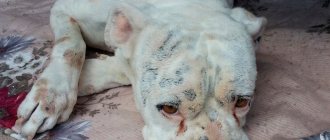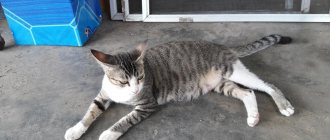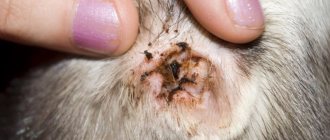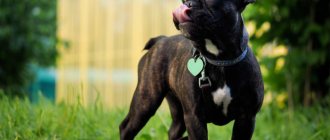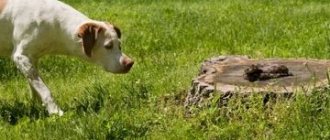Targeted poisoning of animals is the scourge of our century. Every owner of a four-legged pet has heard at least once about the so-called “dog hunters.” These are people who love and know how to scatter poisons in walking areas in order to destroy someone else's dog. One of the main toxic substances in their arsenal is isoniazid, which is also called tubazid.
Poisoning of dogs with isoniazid is a common phenomenon, which is due to the fact that this drug can be easily purchased at a pharmacy for pennies. This substance is safe for people, but lethal for dogs. All this makes tubazide a universal poisonous agent. The article will discuss in detail how to identify the symptoms of dog poisoning with this substance, how to provide first aid to the animal and how to protect your pet from dog hunters.
Isoniazid - poison or medicine?
The essence of the action of isoniazid is that it interferes with the activity of mycobacteria, which cause tuberculosis in humans. Its effectiveness has been confirmed by many studies. It should be added here that tablets and powder can be purchased at any pharmacy, and absolutely without a prescription. Therefore, tubazide is a medicine for humans.
For the canine family, isoniazid is one of the strongest poisons. This is due to the fact that the dog’s body does not have an enzyme that can decompose the active components of the drug into harmless substances. This makes Tubazid a powerful weapon that can easily poison any dog. Cheapness and availability even led to its use in the dog catching service, as a poison that was used to destroy stray dogs on a gigantic scale. However, the activities of animal rights activists have fortunately stopped this painful practice.
If within the state isoniazid has become a prohibited substance, with the help of which stray dogs were eliminated, then in the hands of dog hunters it is still a powerful means of poisoning. A tasteless substance with no characteristic odor, it seems to have been specially created for such criminal purposes. Stuck into a piece of sausage is an ideal bait for an animal. Let's talk in more detail about the symptoms of isoniazid poisoning in dogs.
Toxicity of isoniazid to dogs
Isoniazid (tubazid, nicotinic acid hydrazide) is a tablet for tuberculosis in humans. Of all mammals, only canines are extremely sensitive to this drug. The drug is so toxic to them because the dog’s body cannot process it due to the weak activity of its own N-acetyltransferase enzyme.
The effect on dogs develops rapidly: tubazide is easily absorbed in the small intestine. Ingestion of a substance into the body leads to:
- A sharp drop in the level of pyridoxine (one of the forms of vitamin B6). The synthesis of GABA (gamma-aminobutyric acid), an important inhibitory neurotransmitter of the central nervous system, decreases, which leads to the development of seizures.
- The formation of lactic acid in the muscles increases , and under the influence of poison its excess is not processed. Next, the metabolic process of glucose formation is disrupted - the monosaccharide ceases to enter the brain cells. The development of hypoglycemic coma is accompanied by failure of some parts of the brain and paralysis of the respiratory muscles.
- The animal dies from oxygen starvation and poisoning by products of impaired metabolism. Death occurs in a state of upset consciousness, when the dog does not feel pain.
Isoniazid tablets are easy to buy at any pharmacy. Knowing the harm the drug can cause to animals, dog hunters can purchase anti-tuberculosis medicine without a prescription to add tablets to deadly baits and poison dogs. The natural urge to vomit for animals is blocked by anti-emetic drugs added to the bait. Therefore, without timely assistance, a mixture of drugs can kill an animal in a matter of hours.
Symptoms of poisoning
In large cities, isoniazid poisoning in dogs is far from uncommon. Veterinarians say that a lethal dose even for a large dog is 3-4 tablets, 300 mg each. The substance is quickly absorbed by the gastrointestinal tract, entering the blood. The effect of the poison begins within half an hour after consumption; it largely depends on the specific gravity of the animal. The smaller the pet, the easier it is to poison it. A puppy of any breed falls into a special risk zone; without prompt help from Tubazid, he can die in a matter of minutes.
The owner should pay attention to the following signs characteristic of isoniazid poisoning in dogs:
- Most poisonous substances first affect the brain. Therefore, the animal’s coordination of movements is impaired. The pet becomes as if “drunk”, may not get into the doorway, fall on its side, its paws become entangled. The owner should immediately pay attention to these symptoms of poisoning.
- Copious secretion of saliva along with constant thirst is also a clear sign that the animal is poisoned.
- The pet's breathing changes and severe shortness of breath appears.
- Deterioration of the condition is accompanied by profuse vomiting and convulsions. The gag reflex is the body's protective reaction to poison. However, some of the particularly zealous “hunters” specifically add antiemetic drugs to the bait, which prevent vomiting and aggravate the situation.
- The dog constantly wants to sleep. This is a sign that the body has begun to give up. In especially severe cases, drowsiness can develop into a coma from which the pet cannot be brought out.
In general, the symptoms of isoniazid poisoning in dogs do not have any obvious signs that will help you independently distinguish that the animal was poisoned with this particular substance. On the other hand, first aid for tubazide poisoning also does not differ from that provided when other poisons enter the body.
Description of the medicinal product
Isoniazid is a medicine used in medicine to treat tuberculosis.
It has proven to be a very effective remedy in the fight against this disease. These are white tablets with an active substance concentration of 300 mg. Inside they are yellow or red-brown. The tablets are water soluble, so when they hit the snow, a pink or red spot appears around them. Since the tablets are tasteless and odorless, they can easily be placed in bait, which the unfortunate animal will eat without suspecting anything. Therefore, Tubazid is increasingly used by dog hunters to poison dogs.
This drug is broken down in the human body. Dogs lack the enzyme responsible for this process; as a result, isoniazid, instead of a medicine, becomes poison for four-legged pets. In addition, there are known cases of cats being poisoned with this drug.
Surgery
The owner's attentiveness is the key to the dog's health. If an animal ate something on the street and then became ill, this is poisoning. There are times when the owner misses that fateful moment when the dog finds the bait and absorbs it. Upon arrival home, symptoms begin to appear, but where they came from is unknown. Under any circumstances, measures must be taken to help the dog cope with the toxins that have entered inside. Here are some of them:
- At the first signs of isoniazid poisoning in a dog, you need to rinse its stomach. Regular table salt, diluted with warm water, will help you do this. You can administer the medicine using a syringe without a needle. There is a special table that helps to calculate what dose is needed depending on the weight of the animal. But in critical conditions, when every second is important, you won’t always remember this information. Therefore, you need to pour in the solution until vomiting begins.
- An enema is an excellent way to quickly remove toxins. The water in it should be barely warm, the volume is calculated based on the weight category of the pet.
- Every experienced dog breeder's medicine cabinet always contains a dose of the antidote pyridoxine (vitamin B6). It is best to inject it into a vein, at a rate of 50 mg per 1 kg of live weight. If the owner does not know how to do this, then the antidote can be administered intramuscularly, although the effect will be weaker. A sign of improvement will be the complete or partial cessation of seizures.
- Laxatives will help cleanse the intestinal walls from the destructive effects of the poison. Magnesium sulfate powder is perfect for this.
- Sorbents, such as activated carbon, will help reduce the impact of toxins. It is crushed, diluted with water and poured into the pet’s mouth using a syringe. To enhance the effect, do this after the dog has taken a laxative.
- The poison also actively affects the cardiovascular system, in particular the heart, so it is necessary to give the animal Corvalol, at the rate of 7 drops per 10 kg of weight.
Poisoning in dogs is a difficult, stressful situation that requires calm and dexterity from the dog owner. After the surgical intervention is carried out and the dog feels better, it is still worth taking him for examination to a specialist.
Recovery of an animal after poisoning
An animal that has survived isoniazid intoxication will need some time to recuperate. Tubazid, entering the body, disables not only the central nervous system, but also a number of other organ systems, so the dog will require special care and nutrition.
Animals often experience long-term difficulties with the musculoskeletal system; the kidneys, liver and entire digestive system - those organs that took the brunt of the blow - require recovery. Often the dog's vision is impaired.
Typically, partial rehabilitation of a dog requires at least a couple of weeks, depending on the dog’s age and weight, state of health before intoxication, and the timeliness of assistance provided.
First of all, recovery must be monitored by a veterinarian. For the first few days, it is better to keep the dog in a hospital under the supervision of specialists.
For the first day, it is not recommended to give the animal food at all: the body is weakened and is not able to expend energy on digesting additional substances. During this time, the kidneys and liver should remove the toxin from the body and should not be burdened with additional tasks. It is important to provide the animal with constant access to water.
On the second day, with the permission of the doctor, the dog can be given low-fat broth. Most of the toxins will be eliminated from the body by this time, and the mucous membranes of the digestive system will begin to recover.
Gradually, you can add liquid porridge in broth to your diet. It is important that these are easily digestible cereals (buckwheat, oatmeal, rice); foods that are difficult to digest should not be given (wet and dry dog food is also prohibited). The dog should be fed in small portions at intervals of 2 hours, no more than 5 times a day. After a few days, your pet should be offered lean meat or chicken. You can also add liver, cottage cheese, eggs, and boiled vegetables to your diet.
Even if outwardly the dog begins to look healthier, this does not mean that it has fully recovered. So, the internal organs will take a long time to return to normal, so you need to restrain yourself from the desire to pamper your pet with treats from the table.
Recovery period
The insidiousness of tubazid is that its influence does not pass without leaving a trace on the pet. Even if the pet is saved, its gastrointestinal tract and nervous system have still undergone malignant changes, which will take several months to eliminate. On the first day, any food is contraindicated for the dog; only water is allowed. The diet for the next two weeks should include only porridge cooked in water, boiled lean meat and special food.
The veterinarian can prescribe a course of IV drips and health procedures for the animal. The dog should be at rest; shocks are contraindicated for it. The owner must take all such recommendations responsibly. This will help your pet get into shape faster.
Instructions for the use of isoniazid for tuberculosis
Isoniazid is effective against certain mycobacteria that provoke the development of the disease.
Absorbed very quickly: within 1-4 hours after oral administration.
It is available in ampoules of 5 ml, in tablets (packages of 10 and 100 tons), in powder and syrup. The medicine is freely sold in pharmacies and has a low cost (80-100 rubles per package of 100 tablets). In large doses, the drug deadly for dogs.
The drug instantly kills the infection, but its overdose can negatively affect the entire body
The dose of the drug is selected individually, taking into account the form of the underlying disease, concomitant pathology and the nature of the course of the disease.
Instructions for use of Tubazid for children: 20-40 mg/kg 2-3 times a week or 10-20 mg/kg per day.
Intramuscularly administered 15 mg/kg 2-3 times a week or 5 mg/kg per day. For children, the medication is administered at 20-40 mg/kg 2-3 times a week or 10-20 mg/kg per day. The duration of therapy is determined individually.
Inhalation treatment: 5-10 mg/kg per day, divided into 1-2 doses.
The medication is prescribed for the treatment of active tuberculosis.
- tuberculous meningitis (combination therapy);
- prevention of the development of tuberculosis in persons who were in contact with a sick patient;
- prevention of the development of tuberculosis in persons who have given a positive reaction to Tuberculin (more than 5 mm) with a confirmed x-ray picture, which indicates a non-progressive process;
- prevention of the development of tuberculosis in children under 4 years of age who have given a positive reaction to tuberculin (more than 10 mm) with a high risk of dissemination.
High dosages have a toxic effect, which is why dogs are poisoned with Isoniazid.
How to avoid poisoning
Experts agree that the owner is largely responsible for the fact that the dog is poisoned. Timely measures will help the dog breeder avoid not only the costs of treatment, but also the very fact of poisoning. Preventive activities are as follows:
- Use a short leash. In dog behavior, the very instinct is to eat everything that smells good and tastes bad. A four-legged friend will be safe if the owner can always pull him away from a tempting piece of ownerless meat on the street that he might be tempted by.
- Training. An ideal option to avoid worrying about the health of the animal. A pet that does not pick up anything on the street or does it only on command runs a much lower risk of poisoning than one that grabs everything in its mouth.
- Muzzle. If the dog is not trained and likes to eat something on the street, then a tight muzzle will be a good preventive measure, which will protect the dog from the risk of running into poison.
- The presence in the first aid kit of basic antidotes and medications that help remove toxins from the body. Remember that pyridoxine administered in time can save your pet’s life, so you should not skimp on purchasing it at the veterinary pharmacy in advance.
IF PETS HAVE BEEN VICTIMS OF POISONING
There are cases where domestic dogs accidentally become victims of poisoned baits. If this happens, your pet will exhibit the following symptoms:
- excessive sleepiness;
- vomit;
- copious discharge of saliva or foam from the mouth;
- slow breathing;
- convulsions (not disappearing after the administration of anticonvulsants).
If these symptoms appear, know that your pet’s life is in danger and you need to act quickly.
You should not force your dog to drink activated charcoal or enterosgel.
You will only waste precious time. Your actions should be carried out according to the following plan:
- administer vitamin B6 intramuscularly in a dosage of 5-10 ml;
- for convulsions, administer magnesium intramuscularly, the dosage of the drug will depend on the weight of the animal, namely: less than 10 kg - 2 ml, from 10 kg to 20 kg - 3 ml, more than 20 kg - 5 ml;
- deliver the dog to a medical facility for professional assistance;
- if for some reason delivery to the clinic is delayed, then after stopping the seizures, administer Atoxil adsorbent in an amount of 20 ml.
Even if after all the measures the seizures have disappeared and the dog feels satisfactory, show it to a specialist the next day in order to decide on further treatment.
Read about Gamavit for dogs, the features of its use. Find out about the active drug Sinulox. It will quickly and effectively help your pet.
All the benefits of beef tripe are described in detail here.
"Dog Hunters"
The main risk for any dog is dog hunters. Of course, an animal can accidentally eat isoniazid at home, especially if there are tuberculosis patients in the family, but the risk of this is minimal. In order to protect your pet from poisoning, you need to understand how “dog hunters” most often act. Remember, these people do not always use logic; among them there are those who poison all canines without exception, from stray dogs to pets.
They put poison in pieces of the food that can attract the animal. For example, in a piece of meat or sausage. The places where the poison is spread are chosen carefully, taking into account that there are dogs there. Sometimes a dog hunter chooses as his target a specific pet, which, in his opinion, did something bad to him, for example, barked or scared a child. Such radical actions are dictated by the fact that mostly “hunters” people are not very balanced psychologically and are accustomed to acting on the “tit for tat” principle.
It is recommended to inquire about cases of poisoning before going to a new walking area. Typically, dog breeders willingly share such information in personal conversations or on special forums. The owner should try to remember the person who is showing unhealthy attention to his pet. If a stranger tries to hand feed a dog, this must be strictly stopped. Only proper education of the dog and your own attentiveness will help you avoid the harmful actions of dog hunters.
In conclusion, I would like to say that the health of a dog largely depends on its owner. This may concern both training in early childhood, a short leash and muzzle, and the presence of an antidote in the first aid kit. All this, potentially, will reduce the risk of death from a poison such as tubazide to a minimum.
How dog hunters work
As a rule, dog hunters have one method of poisoning animals: they use a “delicacy” stuffed with a toxic substance. The poison is mixed with minced meat and small “cutlets” are formed. Or they put the tablets inside pieces of the cheapest liver or liver sausage. Having given the four-legged poison in an edible shell, the “missionaries” can be absolutely sure that the dog will probably eat it.
But there are several ways to poison an animal:
- The most common and most dangerous method that dog hunters like to use is when they can commit their atrocities and remain unnoticed. “Baits” are scattered in places where stray dogs are most concentrated: near landfills, garbage cans, garages. Often the poison is spread in parks and squares, near children's playgrounds and even in special places for mass dog walking.
- Dog hunters also consider the following method to be quite effective, since all dogs are essentially hunters and instantly react to a moving target. They approach a pack of dogs and throw a “treat”.
- Well, the third method is used by especially arrogant “defenders” of cleanliness, who do not fear reprisals and are confident in their rightness and impunity. They approach the dog and give it the bait directly from their hand. Knowing the possible methods of poisoning animals and the “favorite” places where dog hunters love to “work”, it will be easier for you to prevent trouble in time.
First aid
If little time has passed since the poisoning, the animal is conscious, there are no convulsions, no muscle spasms, in order to cleanse the body of the poison, it is necessary to provoke vomiting, after which it is necessary to inject the pet with an antidote, give the dog sorbents, laxatives.
First aid for a dog in case of poisoning
To induce vomiting in a dog, to cleanse the body of isoniazid, a large amount of warm water with the addition of table salt and baking soda is poured into the pet’s mouth through a syringe without a needle at the rate of one tablespoon of salt/soda per 250 ml of water. You can induce vomiting in a dog by mixing a 3% solution of hydrogen peroxide with water in a 1:1 ratio.
The antidote for isoniazid poisoning in dogs is pyrodoxine, vitamin B6. To save the life of your faithful friend until a veterinary specialist arrives, give your dog an intravenous or intramuscular injection of pyrodoxine, which can be purchased at a regular pharmacy. You can purchase the injection solution without a prescription.
The dosage of the injectable drug is calculated based on the dog’s body weight: 1 ml per five kilograms of weight. For example, for dogs over 20 kg, 7 ml of antidote should be administered. The drug is absolutely non-toxic for animals, well tolerated by dogs, so even if the dosage is exceeded, no side effects are noted.
Pyrioxine for injection is an effective antidote for isoniazid poisoning in dogs.
After administering the antidote, after a few minutes the convulsions and spasms stop, the dog regains consciousness, and the condition returns to normal. If after ten minutes the convulsions have not passed, magnesium sulfate is injected intramuscularly. For dogs weighing more than 20 kg, it is enough to administer 5 ml of the drug. Before giving the injection, carefully read the instructions for the medication!
First of all, it is necessary to remove the harmful substance from the body. You can only induce vomiting if the dog is conscious and not bothered by convulsions. This usually occurs at the first stage of poisoning.
To induce vomiting, use:
- Regular table salt. You can add 1/2 tsp. on the root of the tongue, but usually a saturated solution is made (1 tablespoon per glass of warm water), which the dog must drink.
- Soda. The proportions are the same as for saline solution.
- Hydrogen peroxide. Take 1 part peroxide (1.5%) to 2 parts water.
- Potassium permanganate. Prepare a weak solution (pale pink). The dosage depends on the weight of the dog, but the standard dose is no more than three liters.
Remember! If more than an hour has passed since you ate isoniazid, it is not advisable to induce vomiting.
It is necessary to induce vomiting in a dog, which will help with regular table salt.
If your pet has symptoms of poisoning, you must quickly induce vomiting. To do this, a warm saline or soda solution is forcibly poured into the mouth (a tablespoon of salt or soda is dissolved in a glass of water). You can also use hydrogen peroxide by mixing it with water in a 1 to 1 ratio.
You should not induce vomiting if the dog is already experiencing incoordination and seizures.
The next step is taking adsorbents. The animal should be fed activated carbon (up to 3 grams per kilogram of weight or 8-10 tablets per 10 kg). You can also use enterosgel (a teaspoon of gel is dissolved in a quarter glass of water and forcefully taken out). The drug Polysorb will give a good effect; it is diluted in 50 ml of water (a couple of teaspoons is enough).
After providing first aid, the animal should be immediately taken to a veterinary clinic.
You can also give your pet Corvalol in a dosage of 7-8 drops per 10 kg of body weight. This drug will support the animal's heart muscle.
It is better to leave the pet in a hospital, where she will receive supportive and restorative therapy. It includes intravenous infusions of nutrient solutions, the introduction of potent restorative drugs, etc.
Symptoms of poisoning directly depend on the amount of substance taken and the weight of the dog
Video: dog poisoning with tubazide
Read further:
Can you give your dog activated charcoal and what is the dosage?
How salmonellosis manifests itself in dogs - first symptoms and treatment methods
Is it possible to restore health with hydrogen peroxide?
What powder to take in case of poisoning for children and adults ▶
Use of "Enterofuril" for food and alcohol poisoning
Article rating:
( 1 ratings, average: 5.00 out of 5)
Share with friends:
You may also be interested in:
Vitamin E poisoning
Atropine poisoning - first aid and treatment, what is the fatal outcome
The danger of Kagocel overdose for children and adults
Eutirox overdose - symptoms and consequences, what to do for pregnant women
Features of treatment of poisoning in cats
What should you do if your cat is poisoned? How to start treatment correctly so as not to worsen the situation? Despite the type of toxicity of the poison, it is important to combine it together and evacuate it from the body of the affected animal
It is important to do everything extremely quickly and carefully so that toxins and toxic substances do not have time to be absorbed into the body and spread throughout the entire circulatory system.
Manganese acid solution
Effective medications for cats with intoxication:
- Activated carbon. This drug has an excellent suction or adsorptive function. That is why it is recommended to give Activated Charcoal in case of poisoning, even to animals, especially in the case of food poisoning, in case of intoxication with heavy metals. As for the dosage, it is no more than three tablets per day for a medium-sized animal.
- Enterosgel. It is considered an excellent remedy that helps fight mineral and even organic toxic substances. Suitable for cats of all ages. Regarding the dose, it is equal to ½ teaspoon for an animal weighing 4 kg twice a day.
- Manganese acid solution. Suitable for therapy of various etiologies, as well as in case of damage by poisons of plant origin. You will need five tablespoons of saturated raspberry solution at a time.
Even children can perform such actions. However, it is worth remembering that the disease makes cats not only lethargic, but also very aggressive
It is important to be sensitive to all this when using fixation. If you need to give a tablet, then open the pet’s mouth, place it carefully on the very root of the tongue, and let the swallowing reflex do everything that is necessary.
That is why the animal will unconditionally swallow the medicine. However, there is an easier way; to do this, you need to crush the tablets into powder and then pour them into your mouth.
At the veterinarian's appointment
Thus, if you perform all the proposed manipulations in a timely manner, then therapy at home will be very successful and with a good result. We must not forget that intoxication can be accompanied by complications, therefore, it is better to contact a veterinarian to avoid the death of your pet. There is no need to self-medicate, you should trust professionals, the fate of your pet depends on it.
Symptoms of intoxication
Isoniazid poisoning has its own pronounced symptoms, which manifest themselves quite acutely. When an animal has eaten a Tubazid tablet, the drug is instantly absorbed through the intestinal walls. After about a couple of hours, the maximum activity of the toxic substance in the body of the poisoned animal jumps. The first signs of intoxication appear after 20-50 minutes. This means that the pet owner has approximately an hour and a half to save the life of his pet.
So, the first signs of intoxication are:
- debilitating and intense vomiting;
- complete loss of consciousness;
- coordination of movements is noticeably impaired;
- muscle spasms and random twitching of the paws are observed;
- heart rate increases;
- dyspnea;
- increased salivation;
- strong excitement, abruptly changing to drowsiness and back.
Important: the severity of symptoms depends specifically on the concentration of the drug, the age of the pet, body weight and general condition of the body. https://www.youtube.com/embed/NUq00n_IWKM
It is also worth noting that the general symptoms of Tubazid intoxication are quite similar to dog poisoning from rat poison and other strong chemicals.
If you notice the above signs that indicate severe poisoning, you should immediately provide first aid to your pet and begin treatment. The health and life of your pet depends on the efficiency of your actions.
TREATMENT
First, vitamin B6 . If the dog is over 20 kg, about 7 ml is needed. It is quite difficult to overdo the dosage, since a slight excess will not harm the animal. It will be worse if the amount of this substance is too small.
When the convulsions have stopped and the dog is lying calmly, you need to subcutaneously inject a solution of glucose , always 5%, along with vitamin C into the space between the shoulder blades. In this way, 100 ml of the product is instilled, then the Rheosorbilact solution is used instead of glucose. If a veterinarian does not do this, you will have to regularly put IVs on the dog for about 4 days.
Typically, after taking vitamin B6, cramps go away within 10 minutes. If there is no such effect, it is necessary to inject magnesium sulfate intramuscularly.
Do not administer more than precise dosages. If the animal weighs more than 20 ml, then 5 ml of the substance is needed. A dog weighing between 10 kg and 20 kg will need 3 ml. A small animal up to 10 kg should be limited to 1-2 ml. Many experts advise injecting cocarboxylase, even just once.
Adsense clicker for making money on Google AdSense from 500 to 1000 dollars per month
Let's learn about Milbemax for dogs by reading interesting information. Here you can find everything about treating dogs with Drontal: read in more detail.
If it is not planned to take the dog to the clinic, then when the convulsions go away, you need to inject the diluted sorbent. Quantity approximately 20 ml. It is recommended to choose Atoxil or a similar, practically harmless, but very strong product.
If the dog survives, it is recommended to prescribe it proper treatment. You need to call a veterinarian. The following therapy is usually prescribed: vitamins and cocarboxylase are injected intramuscularly for several days, glucose is injected subcutaneously, and sometimes rheosorbilact.
When a doctor prescribes too expensive, toxic treatment or prescribes a lot of drugs without reasoning and visible reasons for the need for this, you need to be wary. If possible, you should consult with another doctor or additionally carefully read the instructions for the prescribed medications. If you don’t have enough money for medications prescribed by your doctor, you need to ask him to give examples of cheaper ones. It is better to use less effective means, but you should not leave the dog untreated, as this can greatly affect its health in the future.
Video: poisoning in the news
First aid for isoniazid poisoning
In case of isoniazid poisoning, the owner has very little time to save his animal. You should act quickly and decisively, and you should absolutely not panic. First aid is provided by the pet owner. After this is done, the dog should be immediately taken to a veterinary clinic.
Administration of an antidote for isoniazid poisoning
Only the rapid administration of an antidote - vitamin B6 (pyridoxine) can save your pet. If you have a dog at home, purchase this drug and a syringe for its administration. You need to take it with you even while walking. If your dog eats poison on the street and loses consciousness during a walk, you may not have time to bring it home or to the nearest veterinary clinic.
Immediately after administering the medicine, the convulsions will stop and breathing will begin to recover. In case of severe poisoning, the dog may recover only a few hours after the administration of the antidote.
If it happens that you do not have vitamin B6 on hand, urgently take your dog to the veterinary clinic.
Gastric lavage
Administering an antidote is only the first part of first aid. After the injection, you need to start gastric lavage. With its help, you can quickly remove the remaining poison from the stomach, which has not yet had time to enter the bloodstream and act.
In order to flush a dog's stomach, you will need a 20 ml syringe without a needle or a children's pear-shaped enema with a volume of 50-100 ml. The animal should be injected into the mouth with plain water at room temperature, a volume of 100-250 ml (the heavier the dog, the more water is injected), then induce vomiting. This can be done by pressing your finger on the root of the animal's tongue or by pouring a pinch of salt on her tongue.
There is no need to use a solution of potassium permanganate to rinse the gastric cavity. This substance can cause burns to the mucous membrane of the digestive tract and poisoning. There is no benefit from using it. Plain water is no less effective and absolutely safe for the health of the animal.
Sorbents
If you are a dog owner, ask your veterinarian to calculate an individual dose of sorbent for your animal in case of poisoning.
Human or veterinary sorbents can be used to treat dogs. They should be administered through a syringe without a needle into the dog’s mouth.
Rules for first aid and specific treatment for poisoning
The lethal dosage of Isoniazid for dogs is about fifty milligrams per kilogram of canine live weight. Human tablets contain 300 mg of active substance each. Thus, a few tablets are enough to kill a large dog. If you suspect that the dog was poisoned with Isoniazid, you urgently need to administer the appropriate antidote.
Pyridoxine (vitamin B6) is used as an antidote, which must be purchased at any pharmacy without a prescription. You will need a sterile 1% or 5% solution of 1 ml in injection ampoules. For a quick effect, the vitamin must be administered intravenously to the dog, and if this is not possible, intramuscularly. The dose of the antidote should be equal to the amount of isoniazid ingested by the dog.
If you don’t know how much poison has entered your dog’s body, you will need at least fifty milligrams of Pyridoxine per kilogram of weight, i.e. 30-50 ampoules of 1% solution or 6-10 ampoules of 5% solution. You will have to make several injections with a large syringe. When seizures occur, the entire amount of Pyridoxine must be administered within five minutes. If there are no seizures, then the antidote can be administered more slowly, over thirty minutes.
Medical product Hydrogen peroxide
After applying the antidote, the seizures should stop, but the dog remains confused and clouded consciousness for two hours, and sometimes longer. There is no need to worry, since even large doses of vitamin B6 are not toxic and will not cause any harm.
The next step is to induce vomiting in the animal. The usual three percent hydrogen peroxide, which is diluted with water in a ratio of one to one, helps well. The injured dog should be given one tablespoon for every three kilograms of weight. In addition, you can use a solution prepared with baking soda or table salt. To do this, you need to dilute one teaspoon of raw material in one glass of water. If the size of the dog is average, then ½ cup will be enough. For large breeds you will need at least two hundred and fifty milliliters of such a solution. It is better to use warm water for cooking.
When a dog vomits, it needs to be given substances that can quickly and effectively absorb toxic, poisonous substances. Activated carbon helps a lot; you will need 1 or 3 grams per kilogram of the affected animal’s weight. In addition, you can use the following drugs:
- Sorbex;
- Polyphepan;
- Enterosgel;
- Enterosorb and others.
Features of the use of such tablets in case of isoniazid intoxication in dogs: first, they must be crushed into powder, then diluted in water to form a suspension. The resulting medicine should be poured into the corner of the dog’s mouth with a syringe in the amount of one hundred or two hundred milliliters.
Medicine Sorbex
In such a situation, you cannot do without saline laxatives. For dogs, you can use magnesium sulfate, Carlsbad salt, Glauber's salt, or a complex salt laxative used for humans.
To maintain the functions of the heart muscle, you can give a sick animal Corvalol, at the rate of fifteen drops per twenty kilograms of weight.
If the injured dog has convulsions and is unconscious, it is strictly forbidden to provoke the gag reflex, this is dangerous. In addition, if more than two hours have passed since taking the poison, then it is useless to give the animal laxatives and provoke vomiting, there will be no result!
Next, it is necessary to urgently take the dog to a veterinarian to carry out intravenous infusion of detoxification solutions. The veterinarian also prescribes a course of symptomatic therapy, which will help speed up the process of removing decay products from the animal’s body.
If it is not possible to contact a veterinarian, you can independently give the dog an intravenous drip of glucose and saline solution or give a subcutaneous injection (5-10 ml of a five percent glucose solution and 25-40 ml of saline solution).
To stop seizures, you will need Diazepam in an amount of one milligram per kilogram of the animal’s weight.
The drug Valium
To prevent a dog from eating poisoned food on the street, it is important to properly raise and train the animal. Otherwise, it is necessary to walk the dog only with a muzzle to avoid fatal poisoning
